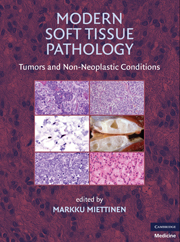Book contents
- Frontmatter
- Contents
- CONTRIBUTORS
- PREFACE
- Chap 1 OVERVIEW OF SOFT TISSUE TUMORS
- Chap 2 RADIOLOGIC EVALUATION OF SOFT TISSUE TUMORS
- Chap 3 IMMUNOHISTOCHEMISTRY OF SOFT TISSUE TUMORS
- Chap 4 GENETICS OF SOFT TISSUE TUMORS
- Chap 5 MOLECULAR GENETICS OF SOFT TISSUE TUMORS
- Chap 6 FIBROBLAST BIOLOGY, FASCIITIS, RETROPERITONEAL FIBROSIS, AND KELOIDS
- Chap 7 FIBROMAS AND BENIGN FIBROUS HISTIOCYTOMAS
- Chap 8 FIBROMATOSES
- Chap 9 BENIGN FIBROBLASTIC AND MYOFIBROBLASTIC PROLIFERATIONS IN CHILDREN
- Chap 10 CHILDHOOD FIBROBLASTIC AND MYOFIBROBLASTIC PROLIFERATIONS OF VARIABLE BIOLOGIC POTENTIAL
- Chap 11 MYXOMAS AND OSSIFYING FIBROMYXOID TUMOR
- Chap 12 SOLITARY FIBROUS TUMOR, HEMANGIOPERICYTOMA, AND RELATED TUMORS
- Chap 13 FIBROBLASTIC AND MYOFIBROBLASTIC NEOPLASMS WITH MALIGNANT POTENTIAL
- Chap 14 LIPOMA VARIANTS AND CONDITIONS SIMULATING LIPOMATOUS TUMORS
- Chap 15 ATYPICAL LIPOMATOUS TUMOR AND LIPOSARCOMAS
- Chap 16 SMOOTH MUSCLE TUMORS
- Chap 17 GASTROINTESTINAL STROMAL TUMOR
- Chap 18 STROMAL TUMORS AND TUMOR-LIKE LESIONS OF THE FEMALE GENITAL TRACT
- Chap 19 ANGIOMYOLIPOMA AND RELATED TUMORS (PERIVASCULAR EPITHELIOID CELL TUMORS)
- Chap 20 RHABDOMYOMAS AND RHABDOMYOSARCOMAS
- Chap 21 HEMANGIOMAS, LYMPHANGIOMAS, AND REACTIVE VASCULAR PROLIFERATIONS
- Chap 22 HEMANGIOENDOTHELIOMAS, ANGIOSARCOMAS, AND KAPOSI'S SARCOMA
- Chap 23 GLOMUS TUMOR, SINONASAL HEMANGIOPERICYTOMA, AND MYOPERICYTOMA
- Chap 24 NERVE SHEATH TUMORS
- Chap 25 NEUROECTODERMAL TUMORS: MELANOCYTIC, GLIAL, AND MENINGEAL NEOPLASMS
- Chap 26 PARAGANGLIOMAS
- Chap 27 PRIMARY SOFT TISSUE TUMORS WITH EPITHELIAL DIFFERENTIATION
- Chap 28 MALIGNANT MESOTHELIOMA AND OTHER MESOTHELIAL PROLIFERATIONS
- Chap 29 MERKEL CELL CARCINOMA AND METASTATIC AND SARCOMATOID CARCINOMAS INVOLVING SOFT TISSUE
- Chap 30 CARTILAGE- AND BONE-FORMING TUMORS AND TUMOR-LIKE LESIONS
- Chap 31 SMALL ROUND CELL TUMORS
- Chap 32 ALVEOLAR SOFT PART SARCOMA
- Chap 33 PATHOLOGY OF SYNOVIA AND TENDONS
- Chap 34 MISCELLANEOUS TUMOR-LIKE LESIONS, AND HISTIOCYTIC AND FOREIGN BODY REACTIONS
- Chap 35 LYMPHOID, MYELOID, HISTIOCYTIC, AND DENDRITIC CELL PROLIFERATIONS IN SOFT TISSUES
- Chap 36 CYTOLOGY OF SOFT TISSUE LESIONS
- Chap 37 SURGICAL MANAGEMENT OF SOFT TISSUE SARCOMA: HISTOLOGIC TYPE AND GRADE GUIDE SURGICAL PLANNING AND INTEGRATION OF MULTIMODALITY THERAPY
- Chap 38 MEDICAL ONCOLOGY OF SOFT TISSUE SARCOMAS
- Index
- References
Chap 26 - PARAGANGLIOMAS
Published online by Cambridge University Press: 01 March 2011
- Frontmatter
- Contents
- CONTRIBUTORS
- PREFACE
- Chap 1 OVERVIEW OF SOFT TISSUE TUMORS
- Chap 2 RADIOLOGIC EVALUATION OF SOFT TISSUE TUMORS
- Chap 3 IMMUNOHISTOCHEMISTRY OF SOFT TISSUE TUMORS
- Chap 4 GENETICS OF SOFT TISSUE TUMORS
- Chap 5 MOLECULAR GENETICS OF SOFT TISSUE TUMORS
- Chap 6 FIBROBLAST BIOLOGY, FASCIITIS, RETROPERITONEAL FIBROSIS, AND KELOIDS
- Chap 7 FIBROMAS AND BENIGN FIBROUS HISTIOCYTOMAS
- Chap 8 FIBROMATOSES
- Chap 9 BENIGN FIBROBLASTIC AND MYOFIBROBLASTIC PROLIFERATIONS IN CHILDREN
- Chap 10 CHILDHOOD FIBROBLASTIC AND MYOFIBROBLASTIC PROLIFERATIONS OF VARIABLE BIOLOGIC POTENTIAL
- Chap 11 MYXOMAS AND OSSIFYING FIBROMYXOID TUMOR
- Chap 12 SOLITARY FIBROUS TUMOR, HEMANGIOPERICYTOMA, AND RELATED TUMORS
- Chap 13 FIBROBLASTIC AND MYOFIBROBLASTIC NEOPLASMS WITH MALIGNANT POTENTIAL
- Chap 14 LIPOMA VARIANTS AND CONDITIONS SIMULATING LIPOMATOUS TUMORS
- Chap 15 ATYPICAL LIPOMATOUS TUMOR AND LIPOSARCOMAS
- Chap 16 SMOOTH MUSCLE TUMORS
- Chap 17 GASTROINTESTINAL STROMAL TUMOR
- Chap 18 STROMAL TUMORS AND TUMOR-LIKE LESIONS OF THE FEMALE GENITAL TRACT
- Chap 19 ANGIOMYOLIPOMA AND RELATED TUMORS (PERIVASCULAR EPITHELIOID CELL TUMORS)
- Chap 20 RHABDOMYOMAS AND RHABDOMYOSARCOMAS
- Chap 21 HEMANGIOMAS, LYMPHANGIOMAS, AND REACTIVE VASCULAR PROLIFERATIONS
- Chap 22 HEMANGIOENDOTHELIOMAS, ANGIOSARCOMAS, AND KAPOSI'S SARCOMA
- Chap 23 GLOMUS TUMOR, SINONASAL HEMANGIOPERICYTOMA, AND MYOPERICYTOMA
- Chap 24 NERVE SHEATH TUMORS
- Chap 25 NEUROECTODERMAL TUMORS: MELANOCYTIC, GLIAL, AND MENINGEAL NEOPLASMS
- Chap 26 PARAGANGLIOMAS
- Chap 27 PRIMARY SOFT TISSUE TUMORS WITH EPITHELIAL DIFFERENTIATION
- Chap 28 MALIGNANT MESOTHELIOMA AND OTHER MESOTHELIAL PROLIFERATIONS
- Chap 29 MERKEL CELL CARCINOMA AND METASTATIC AND SARCOMATOID CARCINOMAS INVOLVING SOFT TISSUE
- Chap 30 CARTILAGE- AND BONE-FORMING TUMORS AND TUMOR-LIKE LESIONS
- Chap 31 SMALL ROUND CELL TUMORS
- Chap 32 ALVEOLAR SOFT PART SARCOMA
- Chap 33 PATHOLOGY OF SYNOVIA AND TENDONS
- Chap 34 MISCELLANEOUS TUMOR-LIKE LESIONS, AND HISTIOCYTIC AND FOREIGN BODY REACTIONS
- Chap 35 LYMPHOID, MYELOID, HISTIOCYTIC, AND DENDRITIC CELL PROLIFERATIONS IN SOFT TISSUES
- Chap 36 CYTOLOGY OF SOFT TISSUE LESIONS
- Chap 37 SURGICAL MANAGEMENT OF SOFT TISSUE SARCOMA: HISTOLOGIC TYPE AND GRADE GUIDE SURGICAL PLANNING AND INTEGRATION OF MULTIMODALITY THERAPY
- Chap 38 MEDICAL ONCOLOGY OF SOFT TISSUE SARCOMAS
- Index
- References
Summary
Paragangliomas include pheochromocytomas and other paraganglionic tumors that are neural autonomic nervous system-related tumors showing neural differentiation. They are presumably derived from paraganglionic cells. Gastrointestinal autonomic nerve tumor (GANT) is now classified as a gastrointestinal stromal tumor (GIST) and is discussed in Chapter 17. Neuroblastoma, a primitive childhood tumor with sympathetic nerve differentiation, and ganglioneuroma, the most differentiated member of the same family, are included in Chapter 31.
OVERVIEW OF THE PARAGANGLIA
The paraganglia are collections of specialized neural cells that serve neurosecretory and neuroreceptive functions at various sites, such as oxygen sensing in the carotid bodies. The paraganglia include the adrenal medulla, and small paraganglia along the para-aortic sympathetic nervous chains around the aorta in the abdomen and thorax (sympathetic paraganglia), and associated with the parasympathetic nervous system, especially in the neck associated with carotid arteries (carotid body) and the vagus nerve (vagal paraganglia). Organ-based paraganglia include the adrenal medulla and small clusters of paraganglionic cells that occur in the urinary bladder and the mesenteries, and around the gallbladder, heart, and lungs, among others.
Normal paraganglia are composed of neural cells, the chief cells that are typically clustered as spherical collections (“cell balls,” originally described as Zellballen in German texts. These structures are sometimes seen in surgical specimens, especially from the abdomen (Fig. 26.1).
The paraganglioma chief cells are surrounded by Schwann cell–like elongated cells, the so-called sustentacular cells.
- Type
- Chapter
- Information
- Modern Soft Tissue PathologyTumors and Non-Neoplastic Conditions, pp. 755 - 776Publisher: Cambridge University PressPrint publication year: 2010



